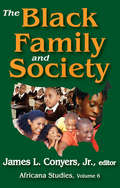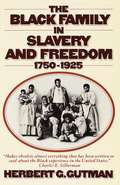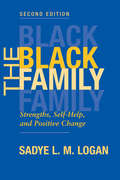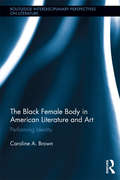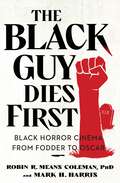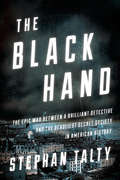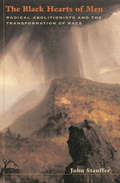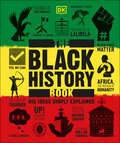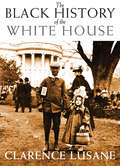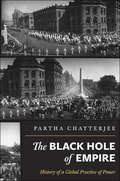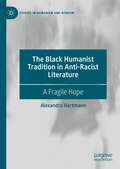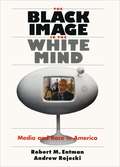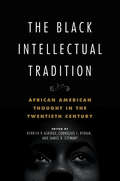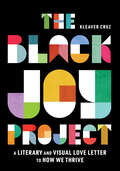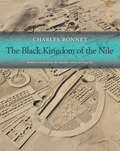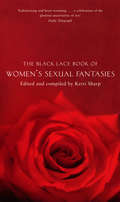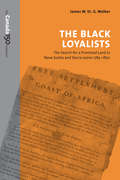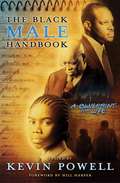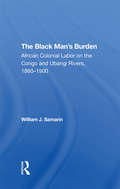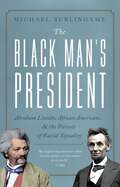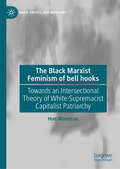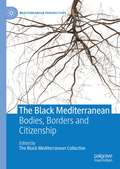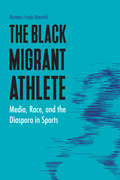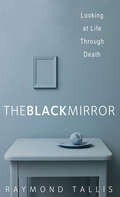- Table View
- List View
The Black Family and Society: Africana Studies (Africana Studies)
by Jr. ConyersThis volume focuses on the black family in the United States and the social forces and issues that affect it, including education, healthcare, racism, poverty, and politics. It examines the effects of these social forces on individuals as well as families.Contributions are varied. "A Biscuit for a Letter" examines education in the antebellum South. "Black Intellectuals on Trial" and "Africans' Perspectives on Race in the US" both analyse the role of race and racism in America. "Feminization of Poverty and the Black Family" illustrates the double burden of race and gender borne by black women. "It's Gotta Be Some Drama!" analyses the televised depiction of black colleges and universities. "African-centred Research Frameworks" studies the importance of cultural awareness in academia. "Work to Be Done" recounts the activism of black women in the Democratic Party.This volume offers an interdisciplinary approach to study of the black family in the United States, taking into account the forces of the larger society that influence it. The Black Family and Society is the most recent volume in Transaction's Africana Studies series.
The Black Family in Slavery and Freedom, 1750-1925
by Herbert G. GutmanAn exhaustively researched history of black families in America from the days of slavery until just after the Civil War.
The Black Family: Strengths, Self-help, And Positive Change, Second Edition
by Sadye LoganWith numerous selections designed to reinforce the goal of empowering clients to take charge of their lives, this revised and updated second edition of The Black Family serves a two-fold purpose. It extends the small but growing body of strength-oriented literature to include African-American families and it serves as a natural extension of current texts on African-American families to provide social workers and the education community with a broader framework for understanding the needs of Black families. Offering both a research orientation and a practice perspective, this book should appeal to social work educators and practitioners involved in family services, health and mental health settings, and child and public welfare.
The Black Female Body in American Literature and Art: Performing Identity (Routledge Interdisciplinary Perspectives on Literature)
by Caroline BrownThis book examines how African-American writers and visual artists interweave icon and inscription in order to re-present the black female body, traditionally rendered alien and inarticulate within Western discursive and visual systems. Brown considers how the writings of Toni Morrison, Gayl Jones, Paule Marshall, Edwidge Danticat, Jamaica Kincaid, Andrea Lee, Gloria Naylor, and Martha Southgate are bound to such contemporary, postmodern visual artists as Lorna Simpson, Carrie Mae Weems, Kara Walker, Betye Saar, and Faith Ringgold. While the artists and authors rely on radically different media—photos, collage, video, and assembled objects, as opposed to words and rhythm—both sets of intellectual activists insist on the primacy of the black aesthetic. Both assert artistic agency and cultural continuity in the face of the oppression, social transformation, and cultural multiplicity of the late twentieth and early twenty-first centuries. This book examines how African-American performative practices mediate the tension between the ostensibly de-racialized body politic and the hyper-racialized black, female body, reimagining the cultural and political ground that guides various articulations of American national belonging. Brown shows how and why black women writers and artists matter as agents of change, how and why the form and content of their works must be recognized and reconsidered in the increasingly frenzied arena of cultural production and political debate.
The Black Guy Dies First: Black Horror Cinema from Fodder to Oscar
by Robin R. Means Coleman Mark H. HarrisA definitive and surprising exploration of the history of Black horror films, after the rising success of Get Out, Candyman, and Lovecraft Country from creators behind the acclaimed documentary, Horror Noire.The Black Guy Dies First explores the Black journey in modern horror cinema, from the fodder epitomized by Spider Baby to the Oscar-winning cinematic heights of Get Out and beyond. This eye-opening book delves into the themes, tropes, and traits that have come to characterize Black roles in horror since 1968, a year in which race made national headlines in iconic moments from the enactment of the 1968 Civil Rights Act and Martin Luther King Jr.&’s assassination in April. This timely book is a must-read for cinema and horror fans alike.
The Black Hand: The Epic War Between a Brilliant Detective and the Deadliest Secret Society in American History
by Stephan TaltySoon to be a major motion picture starring Leonardo DiCaprio, this gripping true story of the origins of the Mafia in America follows the brilliant Italian-born detective who gave his life to stop it. Beginning in the summer of 1903, an insidious crime wave filled New York City, and then the entire country, with fear. The children of Italian immigrants were kidnapped, and dozens of innocent victims were gunned down. Bombs tore apart tenement buildings. Judges, senators, Rockefellers, and society matrons were threatened with gruesome deaths. The perpetrators seemed both omnipresent and invisible. Their only calling card: the symbol of a black hand. The crimes whipped up the slavering tabloid press and heated ethnic tensions to the boiling point. Standing between the American public and the Black Hand’s lawlessness was Joseph Petrosino. Dubbed the “Italian Sherlock Holmes,” he was a famously dogged and ingenious detective, and a master of disguise. As the crimes grew ever more bizarre and the Black Hand’s activities spread far beyond New York’s borders, Petrosino and the all-Italian police squad he assembled raced to capture members of the secret criminal society before the country’s anti-immigrant tremors exploded into catastrophe. Petrosino’s quest to root out the source of the Black Hand’s power would take him all the way to Sicily??—??but at a terrible cost.Unfolding a story rich with resonance in our own era, The Black Hand is fast-paced narrative history at its very best.
The Black Hearts of Men: Radical Abolitionists and the Transformation of Race
by John StaufferAt a time when slavery was spreading and the country was steeped in racism, two white men and two black men overcame social barriers and mistrust to form a unique alliance that sought nothing less than the end of all evil. Drawing on the largest extant bi-racial correspondence in the Civil War era, John Stauffer braids together these men's struggles to reconcile ideals of justice with the reality of slavery and oppression. Who could imagine that Gerrit Smith, one of the richest men in the country, would give away his wealth to the poor and ally himself with Frederick Douglass, an ex-slave? And why would James McCune Smith, the most educated black man in the country, link arms with John Brown, a bankrupt entrepreneur, along with the others? Distinguished by their interracial bonds, they shared a millennialist vision of a new world where everyone was free and equal. As the nation headed toward armed conflict, these men waged their own war by establishing model interracial communities, forming a new political party, and embracing violence. Their revolutionary ethos bridged the divide between the sacred and the profane, black and white, masculine and feminine, and civilization and savagery that had long girded western culture. In so doing, it embraced a malleable and "black-hearted" self that was capable of violent revolt against a slaveholding nation, in order to usher in a kingdom of God on earth. In tracing the rise and fall of their prophetic vision and alliance, Stauffer reveals how radical reform helped propel the nation toward war even as it strove to vanquish slavery and preserve the peace.
The Black History Book: Big Ideas Simply Explained (DK Big Ideas)
by DKLearn about the most important milestones in Black history in The Black History Book.Part of the fascinating Big Ideas series, this book tackles tricky topics and themes in a simple and easy to follow format. Learn about Black History in this overview guide to the subject, great for novices looking to find out more and experts wishing to refresh their knowledge alike! The Black History Book brings a fresh and vibrant take on the topic through eye-catching graphics and diagrams to immerse yourself in. This captivating book will broaden your understanding of Black History, with:- Covers the most important milestones in Black and African history- Packed with facts, charts, timelines and graphs to help explain core concepts- A visual approach to big subjects with striking illustrations and graphics throughout- Easy to follow text makes topics accessible for people at any level of understandingThe Black History Book is a captivating introduction to the key milestones in Black History, culture, and society across the globe – from the ancient world to the present, aimed at adults with an interest in the subject and students wanting to gain more of an overview. Explore the rich history of the peoples of Africa and the African diaspora, and the struggles and triumphs of Black communities around the world, all through engaging text and bold graphics.Your Black History Questions, Simply ExplainedWhich were the most powerful African empires? Who were the pioneers of jazz? What sparked the Black Lives Matter movement? If you thought it was difficult to learn about the legacy of African-American history, The Black History Book presents crucial information in an easy to follow layout. Learn about the earliest human migrations to modern Black communities, stories of the early kingdoms of Ancient Egypt and Nubia; the powerful medieval and early modern empires; and the struggle against colonization. This book also explores Black history beyond the African continent, like the Atlantic slave trade and slave resistance settlements; the Harlem Renaissance and Jazz Age; the Windrush migration; civil rights and Black feminist movements.The Big Ideas SeriesWith millions of copies sold worldwide, The Black History Book is part of the award-winning Big Ideas series from DK. The series uses striking graphics along with engaging writing, making big topics easy to understand.
The Black History of the White House
by Clarence Lusane"Clarence Lusane is one of America's most thoughtful and critical thinkers on issues of race, class and power."-Manning Marable"Barack Obama may be the first black president in the White House, but he's far from the first black person to work in it. In this fascinating history of all the enslaved people, workers and entertainers who spent time in the president's official residence over the years, Clarence Lusane restores the White House to its true colors." --Barbara EhrenreichThe Black History of the White House presents the untold history, racial politics, and shifting significance of the White House as experienced by African Americans, from the generations of enslaved people who helped to build it or were forced to work there to its first black First Family, the Obamas.Clarence Lusane juxtaposes significant events in White House history with the ongoing struggle for democratic, civil, and human rights by black Americans and demonstrates that only during crises have presidents used their authority to advance racial justice. He describes how in 1901 the building was officially named the "White House" amidst a furious backlash against President Roosevelt for inviting Booker T. Washington to dinner, and how that same year that saw the consolidation of white power with the departure of the last black Congressmember elected after the Civil War. Lusane explores how, from its construction in 1792 to its becoming the home of the first black president, the White House has been a prism through which to view the progress and struggles of black Americans seeking full citizenship and justice.Dr. Clarence Lusane has published in The Washington Post, The Miami Herald, The Baltimore Sun, Oakland Tribune, Black Scholar, and Race and Class. He often appears on PBS, BET, C-SPAN, and other national media.
The Black Hole of Empire: History of a Global Practice of Power
by Partha ChatterjeeWhen Siraj, the ruler of Bengal, overran the British settlement of Calcutta in 1756, he allegedly jailed 146 European prisoners overnight in a cramped prison. Of the group, 123 died of suffocation. While this episode was never independently confirmed, the story of "the black hole of Calcutta" was widely circulated and seen by the British public as an atrocity committed by savage colonial subjects. The Black Hole of Empire follows the ever-changing representations of this historical event and founding myth of the British Empire in India, from the eighteenth century to the present. Partha Chatterjee explores how a supposed tragedy paved the ideological foundations for the "civilizing" force of British imperial rule and territorial control in India. Chatterjee takes a close look at the justifications of modern empire by liberal thinkers, international lawyers, and conservative traditionalists, and examines the intellectual and political responses of the colonized, including those of Bengali nationalists. The two sides of empire's entwined history are brought together in the story of the Black Hole memorial: set up in Calcutta in 1760, demolished in 1821, restored by Lord Curzon in 1902, and removed in 1940 to a neglected churchyard. Challenging conventional truisms of imperial history, nationalist scholarship, and liberal visions of globalization, Chatterjee argues that empire is a necessary and continuing part of the history of the modern state.
The Black Humanist Tradition in Anti-Racist Literature: A Fragile Hope (Studies in Humanism and Atheism)
by Alexandra HartmannThis book presents an intellectual history and theoretical exploration of black humanism since the civil rights era. Humanism is a human-centered approach to life that considers human beings to be responsible for the world and its course of history. Both the heavily theistic climate in the United States as well as the dominance of the Black Church are responsible for black humanism’s existence in virtual oblivion. For those who believe the world to be one without supernatural interventions, human action matters greatly and is the only possible mode for change. Humanists are thus committed to promoting the public good through human effort rather than through faith. Black humanism originates from the lived experiences of African Americans in a white hegemonic society. Viewed from this perspective, black humanist cultural expressions are a continuous push to imagine and make room for alternative life options in a racist society. Alexandra Hartmann counters religion’s hegemonic grasp and uncovers black humanism as a small yet significant tradition in recent African American culture and cultural politics by studying its impact on African American literature and the ensuing anti-racist potentials. The book demonstrates that black humanism regards subjectivity as embodied and is thus a worldview that is characterized by a fragile hope regarding the possibility of progress – racial and otherwise – in the country.
The Black Image in the White Mind: Media and Race in America (Studies In Communication, Media, And Pub Ser.)
by Andrew Rojecki Robert M. EntmanLiving in a segregated society, white Americans learn about African Americans not through personal relationships but through the images the media show them. The Black Image in the White Mind offers the most comprehensive look at the intricate racial patterns in the mass media and how they shape the ambivalent attitudes of Whites toward Blacks. Using the media, and especially television, as barometers of race relations, Robert Entman and Andrew Rojecki explore but then go beyond the treatment of African Americans on network and local news to incisively uncover the messages sent about race by the entertainment industry-from prime-time dramas and sitcoms to commercials and Hollywood movies. While the authors find very little in the media that intentionally promotes racism, they find even less that advances racial harmony. They reveal instead a subtle pattern of images that, while making room for Blacks, implies a racial hierarchy with Whites on top and promotes a sense of difference and conflict. Commercials, for example, feature plenty of Black characters. But unlike Whites, they rarely speak to or touch one another. In prime time, the few Blacks who escape sitcom buffoonery rarely enjoy informal, friendly contact with White colleagues—perhaps reinforcing social distance in real life. Entman and Rojecki interweave such astute observations with candid interviews of White Americans that make clear how these images of racial difference insinuate themselves into Whites' thinking. Despite its disturbing readings of television and film, the book's cogent analyses and proposed policy guidelines offer hope that America's powerful mediated racial separation can be successfully bridged. "Entman and Rojecki look at how television news focuses on black poverty and crime out of proportion to the material reality of black lives, how black 'experts' are only interviewed for 'black-themed' issues and how 'black politics' are distorted in the news, and conclude that, while there are more images of African-Americans on television now than there were years ago, these images often don't reflect a commitment to 'racial comity' or community-building between the races. Thoroughly researched and convincingly argued."—Publishers Weekly "Drawing on their own research and that of a wide array of other scholars, Entman and Rojecki present a great deal of provocative data showing a general tendency to devalue blacks or force them into stock categories."—Ben Yagoda, New Leader Winner of the Frank Luther Mott Award for best book in Mass Communication and the Robert E. Lane Award for best book in political psychology.
The Black Intellectual Tradition: African American Thought in the Twentieth Century (New Black Studies Series #1)
by James B. Stewart R. Baxter Miller Leonard Harris Claudrena N. Harold Pero Gaglo Dagbovie Cornelius L. Bynum Layli Maparyan Keisha N. Blain Stephanie Y. Evans Maurice J. Hobson Edward Onaci Nikki M. Taylor Derrick P. Alridge Jeffrey Lamar Coleman Aaron David Gresson La TaSha Levy Zebulon V. Miletsky Venetria K. PattonConsidering the development and ongoing influence of Black thought From 1900 to the present, people of African descent living in the United States have drawn on homegrown and diasporic minds to create a Black intellectual tradition engaged with ideas on race, racial oppression, and the world. This volume presents essays on the diverse thought behind the fight for racial justice as developed by African American artists and intellectuals; performers and protest activists; institutions and organizations; and educators and religious leaders. By including both women’s and men’s perspectives from the U.S. and the Diaspora, the essays explore the full landscape of the Black intellectual tradition. Throughout, contributors engage with important ideas ranging from the consideration of gender within the tradition, to intellectual products generated outside the intelligentsia, to the ongoing relationship between thought and concrete effort in the quest for liberation. Expansive in scope and interdisciplinary in practice, The Black Intellectual Tradition delves into the ideas that animated a people’s striving for full participation in American life. Contributors: Derrick P. Alridge, Keisha N. Blain, Cornelius L. Bynum, Jeffrey Lamar Coleman, Pero Gaglo Dagbovie, Stephanie Y. Evans, Aaron David Gresson III, Claudrena N. Harold, Leonard Harris, Maurice J. Hobson, La TaSha B. Levy, Layli Maparyan, Zebulon V. Miletsky, R. Baxter Miller, Edward Onaci, Venetria K. Patton, James B. Stewart, and Nikki M. Taylor
The Black Joy Project
by Kleaver CruzThe perfect holiday gift for the book lover, art enthusiast and freedom fighter in your lifeFeaturing 117 full-color photos and eight breathtaking essays on a force that fuels Black life all around the globe, this is Humans of New York meets The Black Book"A patchwork quilt of visually stunning images, captured moments of triumph, antidotes to trauma narratives and rich, ebullient emotional and verbal spice for the soul." – Michael W. Twitty, culinary and cultural historian, and author of The Cooking Gene and Koshersoul"In literature, there are some books that transcend mere pages and ink, becoming essential pieces of cultural expression. One such book poised to make its mark is The Black Joy Project…. This ambitious work breaks new ground." – EssenceBlack Joy is everywhere. From the bustling streets of Lagos to hip-hop blasting through apartment windows in the Bronx. From the wide-open coastal desert of Namibia to the lush slopes of Jamaica’s Blue Mountains. From the thriving tradition of Candomblé in Bahia to the innovative and trendsetting styles of Soweto, and beyond, Black Joy is present in every place that Black people exist. Now—at last—is a one-of-a-kind celebration of this truth and a life-giving testament to one of the most essential forces that fuels Black life: The Black Joy Project.International in the scale, fist-raising in the prose, and chockfull of gorgeous works by dozens of acclaimed artists, The Black Joy Project does what no other book has ever done. In words and art, it puts joy on the same track as protest and resistance … because that is how life is actually lived. Uprisings in the street, with music as accompaniment. Heartbreaking funerals followed by second line parades. Microaggressions in the office, then coming home to a warm hug and a garden of lilacs. The list goes on.Black Joy is always held in tension with broader systemic wounds. It is a powerful, historically important salve that allows us to keep going and reimagine new ways of being. The Black Joy Project captures these dual realities to incredible, unforgettable effect.The brainchild of educator and activist Kleaver Cruz, The Black Joy Project is an extension of a real-world initiative of the same name. It has become a source of healing and regeneration for Black people of all backgrounds and identities. Long overdue and somehow still worth the wait, The Black Joy Project is a necessary addition for any book lover, art enthusiast, or freedom fighter. And begs the question, What does Black Joy mean to you?
The Black Kingdom of the Nile
by Charles BonnetFor centuries, Egyptian civilization has been at the origin of the story we tell about the West. But Charles Bonnet’s archaeological excavations have unearthed extraordinary sites in modern Sudan that challenge this notion and compel us to look to black Africa and the Nubian Kingdom of Kush, where a highly civilized state existed 2500–1500 BCE.
The Black Lace Book of Women's Sexual Fantasies (Black Lace Book Of Women Sexual Fantasies #3)
by Kerri SharpThe Black Lace Book of Women's Sexual Fantasies reveals the most private thoughts of hundreds of women. Here are sexual fantasies which on first sight appear shocking or bizarre - such as the bank clerk who wants to be a vampire and the nanny with a passion for Darth Vader.Kerri Sharp investigates the recurrent themes in female fantasies and the cultural influences that have determined them: from fairy stories to cult TV; from fetish fashion to historical novels.
The Black Loyalists: The Search for a Promised Land in Nova Scotia and Sierra Leone, 1783-1870
by James W. WalkerThere is a Canadian myth about the Loyalists who left the United States after the American Revolution for Canada. The myth says they were white, upper-class citizens devoted to British ideals, transplanting the best of colonial American society to British North America. In reality, more than 10 per cent of the Loyalists who came to the Maritime provinces were black and had been slaves. The Black Loyalists tells the story of one such group who came to Nova Scotia, but didn't stay. James Walker documents their experience in Canada, following them across the Atlantic as they became part of a unique colonial experiment in Sierra Leone.
The Black Male Handbook: A Blueprint for Life
by Kevin PowellAuthor and activist Kevin Powell and contributors Lasana Omar Hotep, Jeff Johnson, Byron Hurt, Dr. William Jelani Cobb, Ryan Mack, Kendrick B. Nathaniel, and Dr. Andre L. Brown deliver an essential collection of essays for Black men at all stages of their lives on surviving and thriving in an unjust world.The Black Male Handbook answers a collective hunger for new direction, fresh solutions to old problems, and a different kind of conversation—man-to-man and with Black male voices, all from the hip hop generation. The book tackles issues related to political, practical, cultural, and spiritual matters, and ending violence against women and girls. The book also features an appendix filled with useful readings, advice, and resources. The Black Male Handbook is a blueprint for those aspiring to thrive against the odds in America today. This is a must-have book, not only for Black male readers, but the women who befriend, parent, partner, and love them.
The Black Man's Burden: African Colonial Labor On The Congo And Ubangi Rivers, 1880-1900
by William J. SamarinThis book is an enquiry into early European colonial expansion in Central Africa especially in upper Zaire (Congo) and Ubangi rivers. It explores the extent to which French and Belgian colonial enterprise were dependent on the African labor and their penetration into Zaire basin.
The Black Man's President: Abraham Lincoln, African Americans, and the Pursuit of Racial Equality
by Michael BurlingameFrederick Douglass called the martyred president "emphatically the black man's president&” as well as &“the first who rose above the prejudice of his times and country.&” This narrative history of Lincoln&’s personal interchange with Black people over the course his career reveals a side of the sixteenth president that, until now, has not been fully explored or understood.In a little-noted eulogy delivered shortly after Lincoln's assassination, Frederick Douglass called the martyred president "emphatically the black man's president," the "first to show any respect for their rights as men.&” To justify that description, Douglass pointed not just to Lincoln's official acts and utterances, like the Emancipation Proclamation or the Second Inaugural Address, but also to the president&’s own personal experiences with Black people. Referring to one of his White House visits, Douglass said: "In daring to invite a Negro to an audience at the White House, Mr. Lincoln was saying to the country: I am President of the black people as well as the white, and I mean to respect their rights and feelings as men and as citizens.&” But Lincoln&’s description as &“emphatically the black man&’s president&” rests on more than his relationship with Douglass or on his official words and deeds. Lincoln interacted with many other African Americans during his presidency His unfailing cordiality to them, his willingness to meet with them in the White House, to honor their requests, to invite them to consult on public policy, to treat them with respect whether they were kitchen servants or leaders of the Black community, to invite them to attend receptions, to sing and pray with them in their neighborhoods—all those manifestations of an egalitarian spirit fully justified the tributes paid to him by Frederick Douglass and other African Americans like Sojourner Truth, who said: "I never was treated by any one with more kindness and cordiality than were shown to me by that great and good man, Abraham Lincoln.&” Historian David S. Reynolds observed recently that only by examining Lincoln&’s &“personal interchange with Black people do we see the complete falsity of the charges of innate racism that some have leveled against him over the years.&”
The Black Marxist Feminism of bell hooks: Towards an Intersectional Theory of White-Supremacist Capitalist Patriarchy (Marx, Engels, and Marxisms)
by Hue WoodsonThis book explores bell hooks' trajectory of work and cohesiveness of thought about the meaning and meaningfulness of black womanhood in terms of a Black Marxist feminism, which uniquely confronts the dimensions of feminism and womanism; the relations between the secular and the religious; the problems of gender and sexism; and the structural and systemic issues of oppression, domination, white supremacy, and capitalism. In making sense of black womanhood in its philosophical, social, cultural, institutional, and historical complexities, hooks' Black Marxist feminism constructs an intersectional theory about what hooks describes as white supremacist capitalist patriarchy. In this sense, hooks' Black Marxist feminism conceptualizes the ways and means by which white supremacist capitalist patriarchy imposes intersectional predicaments upon black womanhood, drawing foundationally on Karl Marx and Fredrich Engels, working within the purview of a host of Marxisms in Antonio Gramsci, Louis Althusser, Karl Kautsky, Nikolai Bukharin, and Georgi Plekhanov, and speaking to the Marxist proclivities of Cedric Robinson, Cornel West, Charles W. Mills, James H. Cone, Stuart Hall, and Angela Y. Davis.
The Black Mediterranean: Bodies, Borders and Citizenship (Mediterranean Perspectives)
by Timothy Raeymaekers Gabriele Proglio Camilla Hawthorne Ida Danewid P. Khalil Saucier Giuseppe Grimaldi Angelica Pesarini Giulia Grechi Vivian GerrandThis edited volume aims to problematise and rethink the contemporary European migrant crisis in the Central Mediterranean through the lens of the Black Mediterranean. Bringing together scholars working in geography, political theory, sociology, and cultural studies, this volume takes the Black Mediterranean as a starting point for asking and answering a set of crucial questions about the racialized production of borders, bodies, and citizenship in contemporary Europe: what is the role of borders in controlling migrant flows from North Africa and the Middle East?; what is the place for black bodies in the Central Mediterranean context?; what is the relevance of the citizenship in reconsidering black subjectivities in Europe? The volume will be divided into three parts. After the introduction, which will provide an overview of the theoretical framework and the individual contributions, Part I focuses on the problem of borders, Part II features essays focused on the body, and Part III is dedicated to citizenship.
The Black Migrant Athlete: Media, Race, and the Diaspora in Sports (Sports, Media, and Society)
by Munene Franjo MwanikiThe popularity and globalization of sport have led to an ever-increasing migration of black athletes from the global South to the United States and Western Europe. While the hegemonic ideology surrounding sport is that it brings diverse people together and ameliorates social divisions, sociologists of sport have shown this to be a gross simplification. Instead, sport and its narratives often reinforce and re-create stereotypes and social boundaries, especially regarding race and the prowess and the position of the black athlete. Because sport is a contested terrain for maintaining and challenging racial norms and boundaries, the black athlete has always impacted popular (white) perceptions of blackness in a global manner.The Black Migrant Athlete analyzes the construction of race in Western societies through a study of the black African migrant athlete. Munene Franjo Mwaniki presents ten black African migrant athletes as a conceptual starting point to interrogate the nuances of white supremacy and of the migrant and immigrant experience with a global perspective. By using celebrity athletes such as Hakeem Olajuwon, Dikembe Mutombo, and Catherine Ndereba as entry points into a global discourse, Mwaniki explores how these athletes are wrapped in social and cultural meanings by predominately white-owned and -dominated media organizations. Drawing from discourse analysis and cultural studies, Mwaniki examines the various power relations via media texts regarding race, gender, sexuality, class, and nationality.
The Black Mirror
by Raymond TallisIn this beautifully written personal meditation on life and living, Raymond Tallis reflects on the fundamental fact of existence: that it is finite. Inspired by E. M. Forster's thought that "Death destroys a man but the idea of it saves him," Tallis invites readers to look back on their lives from a unique standpoint: one's own future corpse. From this perspective, he shows, the world now vacated can be seen most clearly in all its richness and complexity. Tallis blends lyrical reflection, humor, and the occasional philosophical argument as he explores his own postmortem recollections. He considers the biological processes and the senses that opened up his late world and the million-nooked space in which he passed his life. His inert, dispossessed body highlights his ceaseless activity in life, the mind-boggling inventory of his possessions, and the togetherness and apartness that characterized his relationships in the material and social worlds. Tallis also touches on the idea of a posthumous life in the memories of those who outlive him. Readers who accompany Tallis as he considers his life through death will appreciate with new intensity the precariousness and preciousness of life, for here he succeeds in his endeavor to make "the shining hour" shine more brightly.
The Black Notebook
by Michel Tremblay Sheila FischmanIn the heart of the Latin Quarter, meeting place of marginal characters of all sorts, Céline Poulin works the night shift at a cheap and popular restaurant, Le Sélect, serving hamburger platters and spaghetti and meatballs to student misfits, transvestites, hookers and queens from the Main-Montreal's disreputable Boulevard Saint-Laurent. Hanging out with a theatre company in her off hours, Céline sees opening before her a world where it is not only possible, but even desirable to pretend. When the director offers her a role in The Trojan Women, the die is cast.The Black Notebook is Céline's diary, her account of her trials and tribulations, her expectations and her cruel disappointments, because this young waitress at Le Sélect has her own dramatic story to tell, even if only to herself: Céline is a midget.From the theatre of Euripides to the theatre of Montreal's Main, Michel Tremblay-our Balzac-creates and gives voice to some astonishing new characters in this first of a new series of novels. For the characters of The Black Notebook, the first in this trilogy, life is a comedy that barely conceals the cruel and pitiless tragedy of the everyday. With a transcendent eloquence and compassion, Michel Tremblay celebrates how it is possible for Céline to embrace her difference and to flourish-despite that difference, or perhaps, because of it.
